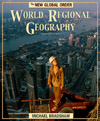 |  World Regional Geography: The New Global Order Update, 2/e Michael Bradshaw,
College of St. Mark and John
Commonwealth of Independent States
Chapter ObjectivesAfter reading and studying this chapter you should be able to:
| 1. Understand the global significance of the break up of the Soviet Union
and the liberation of Eastern Europe and the Balkans. |
 |  |  | | 2. Understand that all countries of this region face a very uncertain
transition from state capitalism within the Soviet bloc to free-market
capitalism within the world economic system. |
 |  |  | | 3. Outline the issues, like the future of nuclear weapons, that concern the
CIS. |
 |  |  | | 4. Examine the roles of nuclear power, oil, and natural gas. |
 |  |  | | 5. Describe the characteristics of agriculture before and after 1991. |
 |  |  | | 6. Define emigres and their reception. |
 |  |  | | 7. Describe the complex ethnic patterns and tensions that are found
throughout the region. |
 |  |  | | 8. Trace the evolution of the Russian Empire to the Union of Soviet
Socialist Republics. |
 |  |  | | 9. Document the numerous environmental problems plaguing this region. |
 |  |  | | 10. Explain how centralization and the "extensive" economic system led to
economic development in the Soviet Union. |
 |  |  | | 11. Understand the plight of the Kalmyks. |
 |  |  | | 12. Describe resource development and industrialization in Siberia. |
 |  |  | | 13. Know the most important characteristics of Irkutsk. |
 |  |  | | 14. Compare and contrast the characteristics of the Ukraine and Armenia. |
 |  |  | | 15. Know that the population of Central Asia, unlike the rest of this region,
is growing despite out-migration of Russians. |
 |  |  | | 16. Understand other ways that Central Asia is different from the rest of the
CIS. |
 |  |  | | 17. Trace the history of urbanization in Russia. |
 |  |  | | 18. Discuss the future of Russia's roles, influences, and desires in relation
to the wants and needs of all the neighboring countries that Russia
used to control. |
|



 2002 McGraw-Hill Higher Education
2002 McGraw-Hill Higher Education